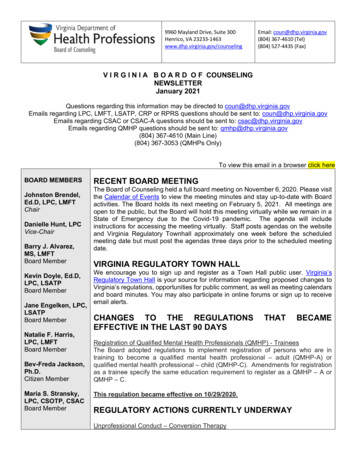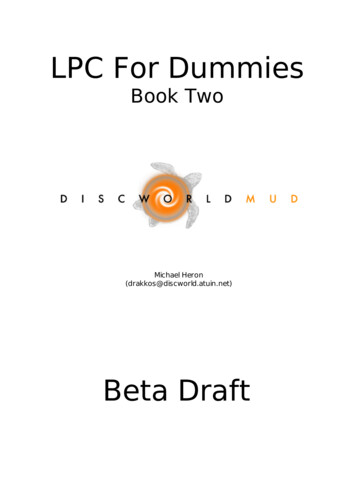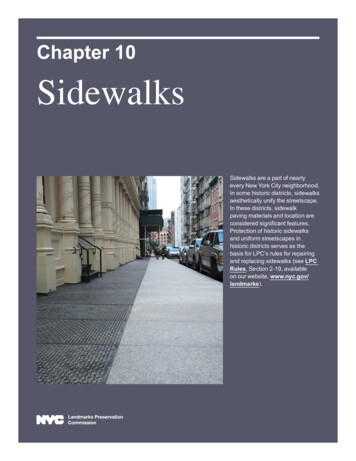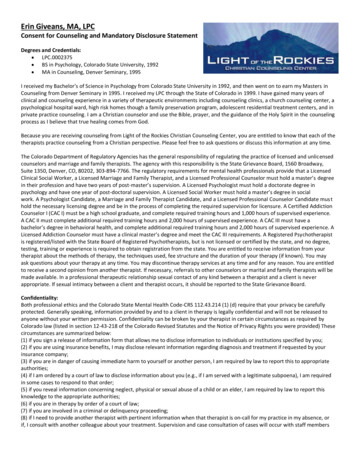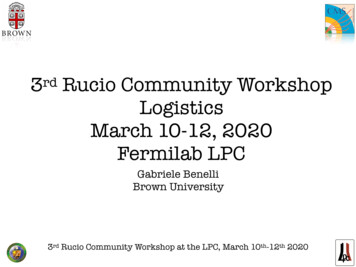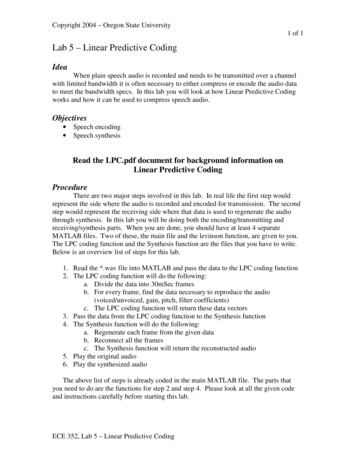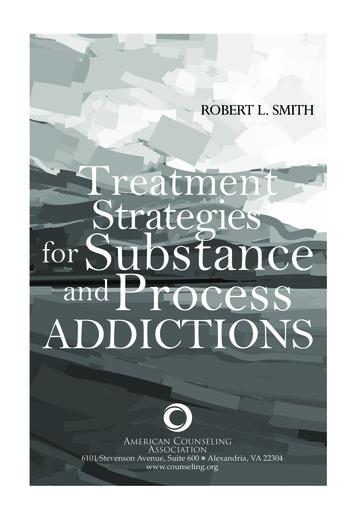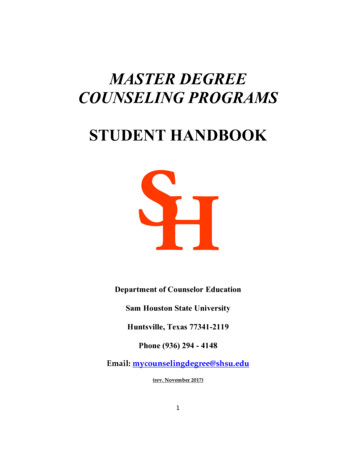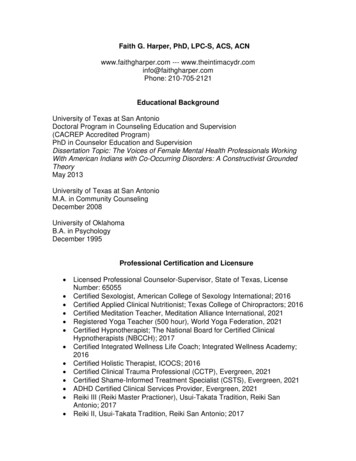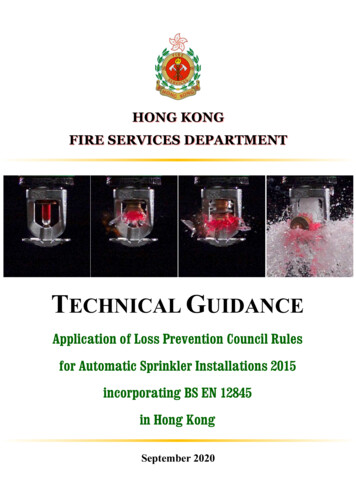
Transcription
HONG KONGFIRE SERVICES DEPARTMENTTECHNICAL GUIDANCEApp icatif r Autfss Preve tiatic SpriC u ci Ru eser I sta ati s 2015i c rp rati g BS E 12845i H g gSeptember 2020
CONTENTSPage2PREAMBLEPART 1 -Abbreviations3 -4PART 2 -Clauses in BS EN 12845:2015 which are either ‘not to beapplied locally’, ‘to be revised’ or ‘for reference only’5 - 30PART 3 -Technical Bulletins in the LPC Rules which are either ‘notto be applied locally’, ‘to be revised’ or ‘for reference only’31 - 571
PREAMBLEThe specification of the design, installation, acceptance testing and maintenance ofsprinkler system in Hong Kong is stipulated in the Codes of Practice for Minimum Fire ServiceInstallations and Equipment and Inspection, Testing and Maintenance of Installations andEquipment, in which the Loss Prevention Council (“LPC”) Rules for Automatic SprinklerInstallations incorporating BS EN 12845 (with suitable modification pertinent to Hong Kong)shall be followed.The first publication of the LPC Rules for Automatic Sprinkler Installations incorporating BSEN 12845: 2003 by the Fire Protection Association has been adopted locally since January2007 vide FSD Circular Letter No. 3/2006. With the release of the LPC Rules for AutomaticSprinkler Installations 2015 incorporating BS EN 12845 (“the Rules”) in November 2015, aSub-working Group (“SG”) of Fire Safety Standards Advisory Group (“FSSAG”) was set up andtasked to conduct a holistic review on the Rules for its applicability and practicability of localadoption. The SG was consisted of members of the FSSAG representing differentstakeholders of the trade including the Hong Kong Institution of Engineers, the Institutionof Fire Engineers, the Society of Fire Protection Engineers – Hong Kong Chapter,Architectural Services Department as well as the Association of Registered Fire ServiceInstallation Contractors of Hong Kong. After comprehensive discussions as well asextensive consultations with the trade and respective parties of interests, the SG hasmeticulously formulated this Technical Guidance by making reference to the figures, tablesand other technical details of the Rules. Except for the clauses/parts of the Rules coveredin this Technical Guidance, all other clauses/parts of the Rules should be followed directly.Relevant clauses/parts of the Rules specified in Part 2 and 3 of the Technical Guidance areeither “not to be applied locally”, “to be revised” or “for reference only” with dueconsideration on the local situations and relevant Code’s requirements.This Technical Guidance is intended to facilitate stakeholders of local trade to apply the Rulesin Hong Kong. It should be read in conjunction with the Rules, including the TechnicalBulletins, Notes, Commentary and Recommendations, and the relevant requirements ofCodes quoted therein. The application of the Rules will be reviewed regularly pertinent tolocal situation.2
PART 1 – AbbreviationsThe following abbreviations shall be used in this guidance:BS EN 12845-BS EN 12845 : 2015 – Fixed Firefighting Systems –Automatic sprinkler system – Design, installation andmaintenanceBD-Buildings DepartmentEECoP-Code of Practice for the Electricity (Wiring) Regulationsissued by the Electrical and Mechanical ServicesDepartmentFH/HR-Fire Hydrant / Hose reelFS Code-Code of Practice for Fire Safety in Buildings, 2011 issued bythe Buildings DepartmentFSCC-Fire Services Communication CentreFSCoP-Codes of Practice for Minimum Fire Service Installationsand Equipment and Inspection, Testing and Maintenance ofInstallations and Equipment issued by Hong Kong FireServices DepartmentHKFSD or FSD-Hong Kong Fire Services DepartmentFSD CL-Fire Services Department Circular LetterLPCB-Loss Prevention Certification BoardLift CoP-Code of Practice for the Design and Construction of Liftsand Escalators issued by the Electrical and MechanicalServices DepartmentLPC Rules or Rules-LPC Rules for Automatic Sprinkler Installations 2015incorporating BS EN 128453
TB-Technical Bulletins encompassed in the Loss PreventionCouncil Rules for Automatic Sprinkler InstallationsIncorporating BS EN 12845 : 2015 and including all updatedTechnical Bulletins in November 2015WSD-Water Supplies DepartmentHow to Use this Technical GuidanceIn this Technical Guidance, information in the entries is arranged in the same order of theRules. One should first read the Clause of the Rules including its TB and then check thecorresponding part of this Guidance in order to apply them properly to suit localrequirements. Below is an example of the arrangement of the entries:4
PART 2 – Clauses in BS EN 12845:2015 which are either ‘not to be appliedlocally’, ‘to be revised’ or ‘for reference only’3Terms and DefinitionsClause 3.15 should be revised and read as“automatic pump supplying water to a sprinkler system from a gravity tank”Note: Booster pump of direct connection to town main is not permitted in Hong Kong.Heading of clause 3.55 should be revised and read as“sprinkler, flush”Note: Ceiling type sprinkler is regarded as a general term.4Contract Planning and DocumentationClause 4.1 and 4.2 are not mandatory and for reference only.Note: System proponent shall follow relevant procedures and requirements as stipulated in the FSD CL.Clause 4.3 c) is not to be applied locally.Clause 4.3 d) should be revised and read as“a statement that the sprinkler system is based on LPC Rules for Automatic SprinklerInstallations 2015 incorporating BS EN 12845 and FSD Technical Guidance.”Note: This is to suit local practice.Clause 4.4.2 i) is not mandatory and for reference only.Note: System proponent shall follow relevant procedures and requirements as stipulated in the FSD CL.Clause 4.4.2 k) should be revised and read as“The design and installation of sprinkler system shall follow LPC Rules for AutomaticSprinkler Installations 2015 incorporating BS EN 12845 and FSD Technical Guidance.”Note: This is to suit local practice.Clause 4.4.4 is not mandatory and for reference only.Note: System proponent shall follow relevant procedures and requirements as stipulated in the FSD CL.5
5Extent of sprinkler protectionClause 5.4 should be revised and read as“Sprinkler protection of concealed space is not required, if the maximum height of theconcealed space at ceiling or floor is not more than 300mm in space and containing no othermaterials except: Bare metal pipeworkMetallic floor boxCables (with voltage less than 250V, single phase) in metallic conduit or trunkingCables complying with FSD CL No. 2/2017 Minimum Fire Resisting CableRequirements for Fire Service Installations”Note: The BS EN Standard is put in place to protect concealed spaces above ceilings and under floors with sprinklers incase of fire risks inside. With due consideration on the practical situation, exemptions are provided to certain conditions.Also, the relevant TB230 is not to be applied locally.7Hydraulic design criteriaThe last two sentences of the first paragraph of 7.1 should be revised and read as“For LH, OH and HHP classes, the minimum requirements for design density and area ofoperation shall follow TB229.3.2. For HHS, the requirements shall follow TB234.”Note: Clause 7.2 has been replaced by TB 234 with suitable revision pertinent to local application.Note to Clause 7.1 should be revised and read as“NOTE For pre-calculated systems, the design criteria shall follow relevant requirementsin Clause 7.3, 9.3.2.2, 10.7.2 and revised TB 210.”Note: Clause 10.7 has been replaced by revised TB210. However, Clause 10.7.2 is maintained to suit local practice.The meaning of the term ‘a1’ of Clause 7.3.2.7 should be revised and read as“The area of operation for design density, in square metres, shall be referred to TB229.3.2for HHP or TB234.5 for HHS.”Note: Table 3 has been replaced by TB229.3.2 and Table 4 has been replaced by TB234.5 (with suitable revision pertinentto local application).6
8Water suppliesClause 8.1.1 should be revised and read as“Water supplies shall be capable of automatically furnishing at least the requiredpressure/flow conditions of the system. The water supply shall have sufficient capacity forthe following minimum durations:-LH 30 minOH 60 minHHP 90 minHHS 90 minThe duration shall be used for fully calculated system purpose.”Note: Water supply used for other firefighting system is not acceptable.Clause 8.3 is not to be applied locally.Note: Connection of other services to the water supply of a sprinkler system is not acceptable locally.Clause 8.4 should be revised and read as“Water supply equipment, such as pumps, pressure tanks and gravity tanks, shall not behoused in sections of premises in which there are hazardous processes or explosion hazards.The water supplies, pumps, stop valves and control valve sets shall be installed such that theyare safely accessible even in a fire situation and the place should be adequately ventilated;control valve set(s) shall be at a fire services access level and readily accessible whenresponding to a fire.”Notes:i)This is to suit local practice and provide safer condition for maintenance and operation.ii)This is to facilitate FSD personnel to gain direct access to control valve set(s) in operation.Clause 8.5.1 c) should be revised and read as“All flow measuring devices shall be listed product accepted by FSD. They shall be rechecked before any test results are used to evaluate the available flow.”Note: This is to suit local practice.Clause 8.5.1 e) should be revised and read as“Pressure readings to be used for the pressure/flow test curve shall only be made by anaccurate test gauge ( 5%).”Note: This is to suit local practice.7
The first sentence of Clause 8.5.2 should be revised and read as“A flow measuring device shall be permanently installed and shall be capable of checkingeach water supply from pump.”Note: This is to suit local practice.The first sentence of Clause 8.5.3 should be revised and read as“Where the water supply is not by an automatic pump or pumps, a flow measuring deviceshall be permanently fixed and shall be capable of checking each water supply.”Note: This is to suit local practice.9Type of water supplyThe second sentence of Clause 9.2 [“A pressure switch shall be installed with a test valve(see Annex I and H.2.5).”] is not to be applied locally.Note: Not mandatory as storage tank is required for sprinkler installation.The second paragraph of Clause 9.2 [“In some cases the water quality objects greaterthan 6 mm diameter to pass.”] is not to be applied locally.Note: WSD’s requirements should be followed.The first paragraph of Clause 9.3.2.1 should be revised and read as“For each system a minimum water volume is specified. This shall be supplied from one ofthe following:a. a full capacity tank, with an effective capacity at least equal to Table 9 & Table 10 forpre-calculated system or clause 9.3.2.3 for fully calculated system.b. a full capacity tank, equivalent with 2/3 capacity as per (a) above, plus direct connectionc.to Service Provider’s Computerized Fire Alarm Transmission System.a reduced capacity tank (see revised clause 9.3.4), where the required water volume issupplied jointly by the effective capacity of the tank plus the automatic infill.”Note: This is to suit local practice.The third paragraph of Clause 9.3.2.1 [“Except for open reservoirs water level indicator.”]should be revised and read as“Except for open reservoirs, tanks shall be provided with overflow and level alarms.”Note: This is to suit local practice.8
The first paragraph of Clause 9.3.3 should be revised and read as“The water source shall be capable of refilling the tank in no more than 24 hours or at rate of75L/min whichever flow rate is larger. However, the tank shall be refilled in 6 hours iftransfer pump is required for refilling.”Note: This is to comply with the section 5.30 of FSCoP.The second paragraph of Clause 9.3.3 [“The outlet of any feed pipe the suction pipe inlet.”]is not mandatory and for reference only.Note: This clause may not be applicable locally, but it shall be taken as a reference for good practice.Clause 9.3.4 b) should be revised and read as“the effective capacity of the tank shall be no less than that shown in Table 11 below for bothend supplies;”Note: This is to meet local requirement.Clause 9.3.4 c) should be revised and read as“the tank capacity plus the inflow shall be sufficient to supply the system at full capacity asspecified in 9.3.2.1;”Note: This is to meet local requirement.Table 11 of Clause 9.3.4 should be revised and read asMinimum effective capacityHazard Classm3LH – (Wet or pre-action)2.5OH1 – Wet or pre-action25OH1– Dry or alternateOH2 – Wet or pre-action50OH2 – Dry or alternateOH3 – Wet or pre-action75OH3 – Dry or alternateOH4 – Wet or pre-actionHHP and HHS1002/3 of the full capacityNote: This is to meet local requirement.The first paragraph of 9.3.6 [“In the case of pumps the tank having to be emptied.”] is notmandatory and for reference only.Note: This is to meet local requirement.9
Clause 9.5.2 b) should be revised and read as“a separate sprinkler protected building complying with local requirements used solely forthe housing of fire protection water supplies and equipment;”Note: This is to meet local requirement.Clause 9.5.2 c) should be revised and read as“an unprotected building complying with local requirements with appropriate fire resistingcompartment.”Note: This is to meet local requirement.The second paragraph of Clause 9.5.2 should be revised and read as“When the pressure tank is housed in a sprinkler protected building, the area shall be enclosedby fire resistant construction complying with local requirements.”Note: This is to meet local requirement.The following new paragraph for Clause 9.6 should be added“A superior single water supplies (detailed in revised clause 9.6.2) or duplicate water suppliesare required.”Note: This is to meet local requirement.Clause 9.6.1 is not to be applied locally.Note: Single water supplies do not comply with section 5.30 of FSCoP.Clause 9.6.2 should be revised and read as“Superior single water supplies are single water supplies which provide a higher degree ofreliability. They shall be agreed with FSD. The acceptable superior water supplies includethe following:a)b)c)a single ended feed from town main supplying suction tank will be accepted providedthat the tank has a full tank capacity equivalent stated in revised clause 9.3.2.1. Two ormore booster pumps shall be provided.both end supplies complying with preceding revised clause 9.3.4 for reduced capacitytank.a gravity tank with or without booster pump, or storage tank with two or more pumps,where the tank fulfils the following conditions: the tank shall be full capacity as per revised clause 9.3.2.1; there shall be no entry for light or foreign matter;potable water shall be used; the tank shall be of concrete construction or LPCapproved.NOTE: For gravity tank with or without booster pump, and storage tank with two or more10
pumps, attention on the maximum water pressure limitation specified in clause 8.2 shall bepaid.”Note: This is to suit local practice.The following sub-clauses for Clause 9.6.3 should be added“c) town main with either a pressure tank, gravity tank or elevated private reservoir is notd)accepted;town main directly connected to automatic pumps is not accepted.”Note: This is to comply with section 5.30 of FSCoP.Clause 9.6.4 is not to be applied locally.Note: Water supply from sprinkler tank to other system is not acceptable.The following new Clause 9.8 should be added and read as“9.8 Sprinkler inletSprinkler inlet shall be provided to the system. Number of sprinkler inlet to be provided should be sufficient to feed in the requiredwater flow rates according to revised TB210 T5 with the maximum water flow rate ofeach sprinkler inlet should be not more than 2000 l/min. At least Two sprinkler inlets shall be provided for high rise installation. Additionalsprinkler inlets may be requested by FSD.All sprinkler inlets of the same 45m Installation Zone shall be interconnected.Pipe size shall be the same as control valve size.” Note: This is to meet local requirement.10PumpsClause 10.7.2 and Figure 7a should not be replaced by TB210 and kept for local application.Note: This is to suit local application.11Installation type and sizeClause 11.1.2.1 should be revised and read as“Parts of the installation subject to freezing may be protected by the use of dry type sprinklersprojecting into the low-temperature area or electrical trace heating or pre-action installations(see 11.4) or subsidiary dry pipe extension (see 11.5).”Note: Dry type sprinklers are commonly used in local practice.11
Clause 11.1.2.2 is not to be applied locally.Note: This clause may not be applicable to local climatic condition.The last sentence of first paragraph of Clause 11.1.2.3 [“The piping shall be provided with national classification system insulation.”] should be revised and read as“The piping shall be provided with a Euroclass A1 or A2 (classified according to BSEN13501-1) or equivalent.”Note: BS EN no. is added for ease of reference.The sixth sentence of second paragraph of Clause 11.1.2.3 [“All trace heated pipework shallbe lagged with with a water resistant covering.”] should be revised and read as“All trace heated pipework shall be lagged with Euroclass A1 or A2 (classified according toBS EN13501-1) or equivalent insulating material of not less than 25mm thick with a waterresistant covering.”Note: BS EN no. is added for ease of reference and suit local practice.The first paragraph of Clause 11.1.3 should be revised and read as“The maximum area (calculated on that portion of area with sprinkler protection) controlledby a single wet alarm valve, including any sprinklers in a subsidiary extension, shall notexceed that shown in Table 17.”Note: This is to in line with the requirements of other installations for calculation of protected area.Clause 11.3 is not to be applied locally.Note: No alternative installation is allowed.Clause 11.4.1.1 should be revised and read as“Pre-action installations can be independent installations or subsidiary extensions from a wetpipe sprinkler installation with the pre-action control valve and associate water motor alarmgong located on the same floor protected by that pre-action sprinkler. They shall be one ofthe following types:”Note: This is to clarify the acceptable designs of pre-action installation and locations of pre-action control valve forsubsidiary extensions.The third paragraph of Clause 11.4.1.2 [“In the event dry pip system.”] should be revisedand read as“In the event of a fault in the fire detection system, the installation shall operate as an ordinarydry pipe system or wet pipe system.”Note: This is to suit local practice.12
Clause 11.4.1.3 should be revised and read as“This is an otherwise normal dry pipe installation in which the control valve set is activatedby an automatic fire detection system and/or by the operation of the sprinklers.For the dry pipe installation in which the control valve set is activated by both the operationof automatic fire detection system and sprinkler may only be allowed for cold rooms.”Note: This is to suit local practice.Clause 11.4.2 should be revised and read as“The detection system shall be installed in all rooms and compartments protected by thepre-action sprinkler system and shall comply with BS EN 5839 part 1 and relevant FSDCLs as far as practicable. Normally, the connection to FSCC of this detection system is notrequired.”Note: This is to suit local practice.The following new paragraph for Clause 11.6 should be added at the end“Water spray system should be installed in accordance with the standards accepted by theFSD.”Note: This is to meet the requirements in FSCoP.12Spacing and location of sprinklersThe first bullet point of Clause 12.3 should be revised and read as“- where arrangements are made to prevent adjacent sprinklers from wetting each other.This may be achieved by a baffle made of metal or fire resistance sheet not less than200mm wide and 150mm high located midway between the sprinklers (when the baffleis fitted on the range pipe, its top edge shall extend above the sprinkler deflector by50mm to 75mm), or by using intervening constructional features;”Note: This is to spell out specifications of the baffle material and its location.The fourth to sixth bullet points of Clause 12.4.1 should be revised and read as“ - 1.5 m from the external open face of open-faced buildings (Buildings of reinforcedconcrete construction with windows or glazing on external walls or curtain wall asexternal wall is not classified as open face buildings);- 1.5 m from external walls where the external walls are of combustible materials;- 1.5 m from external walls where the external walls are of metal, with or withoutcombustible linings or insulating materials;”Note: To clarify that a distance of 1.5m is counted from external open face or wall and specify the definition of open facebuilding.13
The first paragraph of Clause 12.4.2 should be revised and read as“Sprinklers shall be installed not lower than 0.3m below the underside of combustibleceilings or 0.45m below non-combustible ceilings, e.g. Euro Class A1 or A2 or equivalentrequirement as stated in FS Code.”Note: This is to meet requirement in FS Code.Clause 12.4.4 should be revised and read as“The distance from the edge of a canopy to the nearest sprinklers shall not exceed 1.5 m*.*Provision of sprinkler system under the canopy shall comply with revised TB 206.4.3.”Note: This is to clarify the sprinkler installation under canopy.Figure 10 of Clause 12.4.6 should be revised as followsFigure 10 (Revised) – Distance of sprinkler deflector from beamsThe first paragraph of Clause 12.4.7 should be revised and read as“Where narrow bays are formed between beams spaced at not more than 1.5 m betweencentres, where the beams are above 450mm (e.g. case of non-combustible construction A1and A2 or equivalent) or 300mm (e.g. case of combustible construction above A2 orequivalent) in depth, the following spacing shall be used:”Note: This is to meet local requirement.14
The last paragraph of Clause 12.4.7 should be revised and read as“Where the beam depth is above 0.7 m, the sprinkler shall be installed in accordance withClause 12.4.6.”Note: This is to provide an alternative solution.The following new sub-clauses for Clause 12.4.10 should be added“e)f)Sprinkler heads should be installed at least 300mm from the bottom edge of airduct/obstructions etc. in order to accumulate suitable amount of heat tooperate the sprinklers.Sprinkler protection is not required for bay window where the depth of baywindow does not exceed 800mm.”Note: This is to suit local practice.The second paragraph of Clause 12.4.12 should be revised and read as“At least one sprinkler shall be installed at the top of all shafts except where the shaft isincombustible and inaccessible and contains materials in accordance with Euro class A1 orequivalent except electrical cabling.”Note: This is to meet local requirement.The following new paragraph for Clause 12.4.12 should be added at the end“Enclosed chutes through floors inside or in communication with sprinklered buildings shallbe fitted with sprinklers. Lift complying with Lift CoP are not required to be fitted withsprinklers.”Note: This is to meet local requirement.The last paragraph of Clause 12.4.14 should be revised and read as“Where obstruction such as ductworks above the ceiling with width of 800mm or above forrectangular shape or 1000mm or above for circular shape, additional sprinkler protection isrequired below the obstruction.”Note: To suit local practice, additional sprinkler protection for obstructions inside ceiling void is required.The following new paragraph for Clause 12.4.14 should be added at the end“If all the above requirements cannot be met, an additional layer of sprinklers with watershield shall be provided underneath the suspended open cell ceiling.”Note: This is to suit local practice.15
13Pipe sizing and layoutClause 13.3.4.2 should be revised and read as“The pipe diameters between the design points of the installation and the control valve setshall be hydraulically calculated using Table A to ensure that the total pressure loss due tofriction with a flow of 1000 l/min does not exceed 0.5 bar, except as modified in 13.3.4.3 and13.3.4.4.”Table A – Pressure loss per unit length of pipe for design flow rates in ordinary hazard installationsPipe nominal bore (BS 1387 & BS EN 10255: Medium grade)Pressure loss per unit lengthmmmbar/m653580161004.41500.652000.16Note 1: The equivalent length of an elbow, bend, or tee where the water is turned through an angle, or through a valvewhere the friction loss will be greater than a straight unit length of pipe, shall be determined in accordance with BS ENClause 13.2.4 – ‘Pressure loss through fittings and valves’.Note 2: Where heavy grade steel pipework is used, calculate the pressure loss per unit length in accordance withTB227.2.2.Note: This is to suit local practice.The second paragraph of Clause 13.3.4.3 is not mandatory and for reference only.Note: It is not a local mandatory requirement.14Sprinkler design characteristics and usesClause 14.1 should be revised and read as“NOTE This standard covers only the use of the types of sprinkler specified in EN 12259-1.Sprinkler heads shall comply with EN12259-1 or other standards accepted by FSD.Only new (i.e. unused) and accepted sprinklers shall be used in new installation. The existingsprinkler can be re-used in sprinkler alternation works subject to the condition of sprinkler incompliance with FSD requirement.”Notes:i)This is to add alternate standards for sprinkler head; andii)to allow re-use of existing sprinkler in alterations and additions works.16
Clause 14.2.2 & 14.2.4 should not be replaced by TB207 and kept for local application.Note: This is to suit local application.The first paragraph of Clause 14.2.2 should be revised and read as“Flush, recessed and concealed sprinklers shall not be installed in OH4, HHP or HHS areas.Sprinklers without fixed deflectors, e.g. with retracted deflectors which drop to the operatingposition on actuation, shall not be fitted in the following situations:”Note: To meet local requirement, ceiling sprinklers may be used in OH4, HHP, HHS areas.The description of ‘K’ in Clause 14.3 should be revised and read as“K is K factor given in Table TB207. T1 and T2;”Note: This is to update the reference for the replacement for the table and tally the terms to be used.Clause 14.6 should be revised and read as“When sprinklers, other than concealed, recessed, or flush sprinklers, are installed in aposition at risk of accidental mechanical damage, they shall be fitted with a suitable metalguard.”Note: This is to include concealed and recessed sprinklers.15ValvesThe following new paragraph for Clause 15 should be added“Stop, test, drain and flushing valves shall comply with the appropriate standards and sizerange of Table 38 of BS 5306: Part 2:1990 or other standards accepted by FSD.”Note: The relevant design standards of various types of valves are not mentioned in the LPC Rules. There is a need to addexisting standards with alternate standards.Clause 15.1 should be revised and read as“Each installation shall have a control valve set in accordance with EN 12259-2 or EN 122593 or other standards accepted by FSD.”Note: This is to add alternate standards for control valve set.17
The first paragraph of Clause 15.2 should be revised and read as“All stop valves which may cut off the water supply to the sprinklers shall:close in the clockwise direction;be fitted with an electric monitoring switch to indicate that the valve is in the correctoperational mode;be secured in the right position by a strap and padlock or secured in an equivalentmanner.”-Note: This is to suit local practice by adopting existing requirement.Item e) of Clause 15.4 [“Any pipe through another drain valve.”] is not mandatory and forreference only.Note: This is to suit local practice.The second sentence of paragraph 2 of Clause 15.4 [“The outlet shall with a suitableplug.”] should be revised and read as“The outlet shall be accessible and shall be fitted with a suitable plug.”Note: This is to adopt a flexible approach for installation of the outlet.The first paragraph of Clause 15.5.2 should be revised and read as“A test facility shall be provided, incorporating a test valve with any associated fittings andpipework, delivering a flow equivalent to the discharge from a single sprinkler, connected atthe hydraulically most remote location on a distribution pipe. At least one such test valveshall be provided for each zone.”Note: This is to clarify the requirements.The first paragraph of Clause 15.7.1 should be revised and read as“Pressure gauge fitted to sprinkler installations shall comply with BS 1780 or BS EN 837-1or other standards accepted by FSD and its scale divisions shall not exceed:”Note: This is to add other standards accepted by FSD.16Alarms and alarm devicesThe first paragraph of Clause 16.1.1 should be revised and read as“Each control valve set shall be provided with a water motor alarm in accordance with EN12259-4 or other standards accepted by FSD and a local visual indicator should be providedfor each wet alarm valve, both located as close as possible to the alarm valve. A singlewater alarm motor and gong might be installed common to a group of wet alarm valvesprovided that these are situated in the same valve room and all local visual indicators shall18
be fitted at the alarm gongs to indicate which alarm valve(s) is/are operating. However, forbuildings with a single control valve set, a local visual indicator will not be required.”Note: This is to suit local practice.The first sentence of Clause 16.1.2 should be revised and read as“The water motor shall be installed in such a way
Note: System proponent shall follow relevant procedures and requirements as stipulated in the FSD CL. Clause 4.3 c) is not to be applied locally. Clause 4.3 d) should be revised and read as "a statement that the sprinkler system is based on LPC Rules for Automatic Sprinkler
